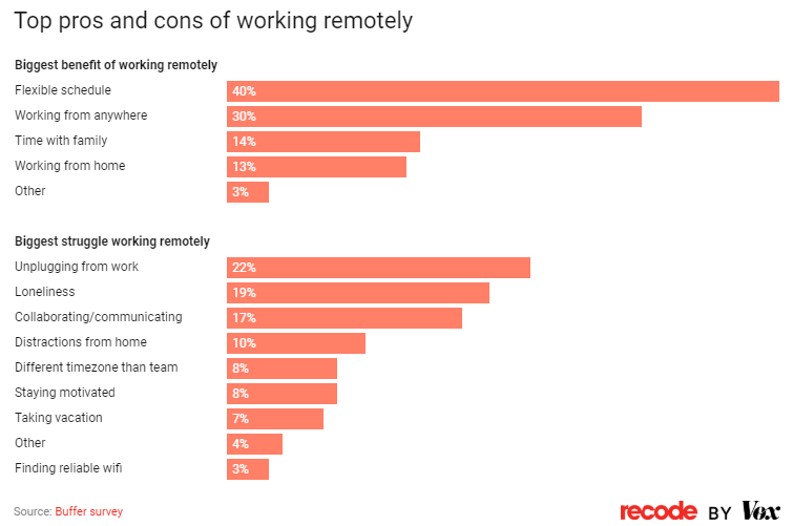
Since 2020, many companies have made the migration to remote work. Others are considering it or have established a hybrid work model. This means many company leaders are scrambling to adapt their procedures and find the most optimal way to communicate. It’s the wild west of workplace culture, so the least you can do is set up some effective work-from-home policies, right?
What is a work from home policy?

Also known as remote work policy or a telecommuting policy, a work from home policy is the established agreement between an employee and their employer. The aim is to cover the varied facets of working remotely. These guidelines define the responsibilities and expectations for the entire team.
It can also identify who will be eligible to work from home or outline the process for requesting privileges and other specifics. During the pandemic, most workers were in mandatory work-from-home situations. For this, companies need to ensure that their employees enjoy a healthful and productive work life geared towards success.
Do you really need work from home policies?
A compelling set of work from home policies offers impressive benefits for employers and employees alike. Here are a few:
Set Expectations
A remote work policy will help set clear expectations on the following:
- Identify employees who can work remotely
- How to request and process approval for remote work
- Determine the work hours
- Set official communication channels
- Give access to IT equipment and support
- Train employees in cybersecurity and confidentiality
- Termination grounds
- Acknowledgment of receipt
Create a Good Work-life Balance
Employees who work from home are given a chance for a better work-life balance. The extra time they get back from having the commute out of the equation is spent on their family and social lives. This helps build well-rounded employees eager to give their best at work. Knowing what they can and cannot do while working from home removes doubts and guilt that may prevent them from thoroughly enjoying the flexibility of working remotely.
Gives the Option of Hiring Globally
When you open your business for remote work, you will gain access to talents from all around the globe. A set of remote work policies will help you manage skills from anywhere in the world and set standards to help you keep your course.
The Pros and Cons of a Remote Work Force

Before you craft effective work from home policies, let’s take a quick look at the pros and cons of working remotely. This will help us understand what needs to be included and what needs to be prioritized.

The Pros
Aside from all the upsides mentioned above, here are a few more benefits of working from home:
- Increase in Productivity – not everyone is a morning person, but they still do the grind. With the flexibility that WFH offers, they can work according to their body clock. They can perform during their most productive hours.
- Employees Feel Valued – working from home allows for a higher trust level between employer and employee. This adds up to better engagement and an increase in productivity.
- Fewer Expenses – employers can cut down on utilities and rental space expenses. For employees, they save up on gas and other transportation costs.
The Cons

As with any situation, working from home also has its downsides. However, they aren’t deal-breakers as the positives still outweigh the negatives. The key is to create policies and processes to manage all these drawbacks. Here are a few of the cons of remote work:
- Distractions – the mere presence of the TV or bed can be distracting enough, add to that the loud noises from your family members and many other distractions. For this, you may need to establish a home office setup that allows you to avoid them.
- Feelings of Isolation – while meetings or brainstorming sessions can be done remotely, there’s nothing that can replace physical interaction with colleagues. A weekly or monthly face-to-face meeting can do the trick.
- Miscommunications – messaging tools and communication platforms abound, but communication errors are still a reality. Differing time zones can also add to the problems. The workaround is to prepare for any miscommunication eventuality by allocating more time for projects and collaborations.
How to Create Work From Home Policies and Procedures

An efficient work from home policy will outline expectations both from employers and employees. Once you create this, include it in your employee handbook, send an email blast, and post them on company announcement boards. Here’s a guideline on how you can write yours.
1. Identify and Establish Your Company Purpose
Explain, describe, and specify the purpose of the document and your goals for the shift to remote work. If applicable, gather data you learned from your company’s experience with the WFH setup. Let them know about this and tell them what needs to stay and what needs to be scrapped.
Your work from home agreement should state your objectives and what you aim to achieve with the setup. Communicate why the policy is essential and how it will be implemented. Overall, the policies should enhance the employee value proposition and their experience with your organization.
2. Define the Scope and Eligibility
First, you need to define the roles within your company that are eligible for remote work. Then, you need to clearly state the restrictions to avoid the frustrations of those who were denied the WFH requests. Lastly, give a concise definition of who is eligible to work from home and who isn’t.
3. Create an Outline for the Request and Approval Process
Include a provision in your work from home policy regarding the processes for request and approval to work remotely. Is there a form to fill out? Who should they send it to? A step-by-step guide can help answer all these questions.
4. Measurement of Productivity
Business owners would want to measure the amount of work done by their employees when working from home. You can set specific deadlines for tasks or use monitoring tools and software to do it. Let them know about this to make them aware that they’re being tracked and monitored.
5. Guidelines for Time-Keeping
Not only will employers want to measure remote productivity, but they also would want to know how the employees spend their time. Again, time monitoring tools are available at your disposal. You can measure how much time it takes to complete a task and then expect them to follow this.
If they take too long, it only means they are struggling with the task or that they are distracted. If you do decide to use time-monitoring apps, don’t forget to include them in your remote work policies.
What should I include in my work from home policies?

Working at home policy and procedures differ as each company is different. Here are a few essential items you need to include when creating your company’s:
1. Communication Expectations
Establish an official communication channel. Ensure that your company uses only one to avoid confusion and reduce inefficiency. Set guidelines on when and how to respond and acknowledge receipt of messages.
2. Work Hours
Some companies opt to let their employees work anytime they want to as long as they complete their tasks. But some require to complete 8-hour shifts. Either way, define the exact work hours and when employees should report for work.
Furthermore, if you have employees in different parts of the globe, ensure that you take note of the time differences.
3. Acceptable Reasons to Work Remotely
If not everyone in your company works from home, you need to define the acceptable reasons. Below are a few examples:
- Familial responsibilities
- Work-life balance
- Disability or illnesses
- Workday appointments
- Extreme weather conditions
- Emergencies
- Other reasons
4. Compensation and Benefits
Whether the work from home situation has any effect on the compensation and benefits or none at all, include it in your remote work policies. One instance to think about is overtime pay. Many employees have reported they have unpaid overtime, which could lead to reduced morale and burnout. That’s why it’s important that you have a system to track the hours worked to ensure that your employees are well-compensated.
5. Equipment and Tech Support
When switching to remote work, equipment, technology, and support come to mind as they are crucial elements. Technical issues are inevitable, and providing support to employees can help them keep being productive. Whether the equipment they use is their own or company-provided, ensure that they get help in these stressful situations.
6. Attendance and Availability Standards
Having the right people on time and getting their input when you need them are also considerations. This means you need to take note of the attendance and set guidelines on this. Set their timelines to match when you need them and when their submissions are expected.
7. Set Expectations on Productivity and Performance
Some employers are hesitant to offer work from home opportunities for fear that employees may take advantage. For this, you will need to track and monitor their performance and productivity, as earlier discussed. Track completed tasks, create time logs, or use project management tools to record productivity and performance.
How do I create work from home policies with Penji?

It might sound odd that a graphic design company could help you with wfh policies. But this is just one of many projects we’ve tackled with businesses. Your company’s wfh policies will need to be distributed to all employees.
But let’s face it, company handouts can be a drag, especially when they’re perceived as a rigid set of rules. To make it more palatable, you can work with a graphic designer to create remote work documents that stand the test of time.
We design ads, logos, custom illustrations, presentations, and much more. At a fixed monthly rate, you can get all the designs you need on-demand. Simply submit your design requests, get revisions if needed, and be on your way.
Learn more in this Penji unlimited graphic design review.
About the author

Celeste Zosimo
Celeste is a former traditional animator and now an SEO content writer specializing in graphic design and marketing topics. When she's not writing or ranking her articles, she's being bossed around by her cat and two dogs.













